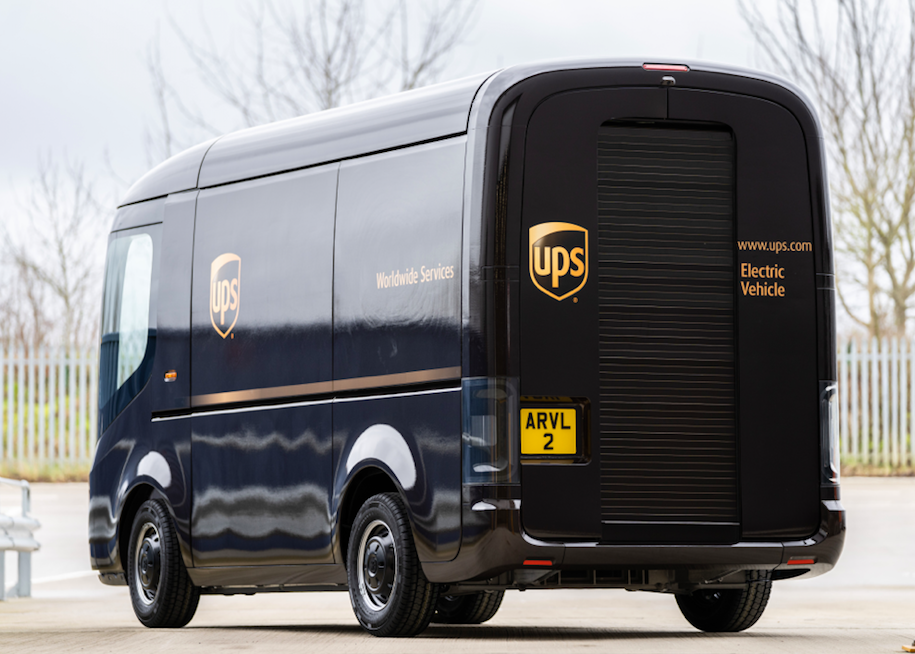
Fleet managers seeking zero emission vehicles have to play a waiting game, while major auto makers slowly adapt their factories and supply chains to new technology. Now, UPS is trying something new: it has invested in an electric vehicle startup called Arrival. The equity arrangement gives UPS dibs on the first 10,000 vehicles produced in Arrival’s new factories.
Purpose-built electric vehicles for special tasks at UPS
Aside from enabling UPS to cut the line for electric vehicles — and cut emissions from its delivery fleet — the company also expects its collaboration with Arrival to create new efficiencies that reduce costs.
As a general rule, electric vehicle fleet owners can anticipate lower costs for maintenance and repairs because electric systems involve fewer moving parts than internal combustion engines. Arrival builds on that advantage by deploying a modular design and standardized parts, including lightweight materials that it fabricates in-house.
To gild the electric vehicle lily, Arrival is also working with UPS on advanced driver assist technology tailored to UPS depots.
If all goes according to plan, the automated system will create new efficiencies in back-office activities as well as in maneuvering, loading and unloading within the depots.
To scale up electric vehicle manufacturing, first scale down
Perhaps the most interesting aspect of the new partnership is Arrival’s unique manufacturing model.
Instead of relying on large, centralized factories, the company plans to establish a number of “micro-factories.”
Depending on where and how the new factories are sited, the arrangement could provide UPS with an opportunity to bring new jobs into communities that need them, rather than encouraging workers to uproot and follow jobs to remote locations.
Aside from the potential benefit to community well-being, the micro-factory concept also provides opportunities for cutting emissions related to worker commutes.
More community benefits from electric vehicles
The idea of small scale, local auto production may seem like a throwback to the days before Henry Ford began mass-producing the Model T. However, 3-D printing and other new technologies have opened up new opportunities for ramping down the size of factories, while also making customization more economical and efficient.
The small-scale manufacturing model caught the eye of the U.S. Department of Energy (DOE) several years ago. In consideration of past collaborations between the DOE and UPS, it’s possible that the agency will keep an eye on the UPS-Arrival venture.
UPS began exploring the idea of a technology partnership with Arrival in 2016, the same year that the company received a DOE grant to help develop a drive-over electric vehicle charging system with vehicle-to-grid capability.
Vehicle-to-grid refers to the idea that electric vehicles are mobile energy storage systems. With the right equipment, the vehicle battery can supply electricity to the local grid or to buildings, field lights and other equipment including other vehicles.
The new chargers could potentially provide both UPS with additional community benefits, by enabling it to provide power for emergency responders and other users in case of a local blackout.
Whatever happened to natural gas?
UPS’s big move into electric vehicles is also interesting, given that just a few years ago the company was championing compressed natural gas as the clean fuel of the future. However, falling costs and improvements in electric vehicle technology are putting a damper on the prospects for expanding the use of natural gas in the transportation sector.
To be clear, UPS is still dedicating resources to compressed natural gas. Just last December, the company announced a new round of 6,000 CNG trucks at a cost of $450 million.
That’s not necessarily good news for natural gas stakeholders, though. Thanks to an alternative fuel onboard system provided by the company Agility Fuel Solutions, the new CNG trucks can include hydrogen among a roster of other fuel options.
Agility also includes hydrogen among its roster of options. That’s another interesting angle, considering that UPS has already shown an interest in pursuing electric vehicles equipped with hydrogen fuel cells.
Though the primary source for hydrogen today is fossil gas, Agility’s connection with renewable sources — including wind and solar power as well as biogas — creates the potential for a renewable hydrogen pipeline.
In light of new evidence about the public health and environmental impacts of the fossil gas supply chain, UPS’s shift to a more sustainable transportation model will serve both the bottom line and its community engagement profile, too.
Image credit: UPS

Tina writes frequently for TriplePundit and other websites, with a focus on military, government and corporate sustainability, clean tech research and emerging energy technologies. She is a former Deputy Director of Public Affairs of the New York City Department of Environmental Protection, and author of books and articles on recycling and other conservation themes.














